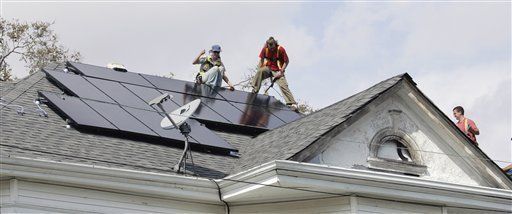
It's a lot easier and less expensive to take your home solar than most people think. Thanks to generous financial incentives from the government and innovative alternatives to purchasing a system, homeowners are discovering there aren't really any risks remaining to going solar.
Like many things, home solar was first adopted by people who were concerned about their environmental and energy footprints. Now, others are following suit, primarily because it makes financial sense. Our electricity rates are going up: the price we pay for residential electricity rose on average 26.8 percent from 2002-2007 in the U.S. With home solar, you essentially lock in a low rate for all the electricity you'll consume in the future--for instance, think about how much you'd save if you could lock in your gasoline price at $1 per gallon for the next twenty years. Over time, going solar today will save you serious cash.
Here are five easy steps to get you started.
1. Figure out your home's solar potential
o If your electricity bill is higher than $100 on average per month, solar can save you money--depending on which purchasing option you choose and your prevailing utility rates, you could see savings of up to 60% within the first month of going solar.
o You'll need enough sunlight on your roof. Geography, roof orientation, and shading are all factors an expert can assess for you.
2. Research your options
o There are a lot of resources on the web. States that offer incentives frequently have websites with good information, and many solar companies have good general information about going solar on their sites as well.
o Most people choose to work with a professional solar company to design and install a home solar system. You can get a good feel for a solar company from its website.
3. Decide what's best for your home and finances
Questions to ask include:
o Should I purchase a system outright or pay as I go? There are alternatives to buying a system all at once that dramatically reduce the upfront costs of home solar and still provide the long-term benefits, including power purchase agreement (PPA) or leasing options.
o What's the best return on my investment? Make sure to consider how your home solar solution will reduce your energy costs over time. Also, investigate how having home solar will factor in if you sell your house.
o Are maintenance and repairs included? Some companies take care of your system for you, others don't.
o Does my solar company have happy customers? Talk to everyone you can before choosing a solar solution and installer. Ask to speak with recent customers to make sure they're happy with their solar experience.
o How will the panels look on my house? Not all home solar installations are created equal when it comes to aesthetics. Choose the product you're most comfortable with.
4. Install your system
o A typical home solar installation will take only four to six days. There will be some additional delays before your system can be turned on after it's installed: your local utility company will need to come out to approve the system and properly connect it to the utility grid.
5. Enjoy your savings
o There's nothing quite like seeing your utility meter spin backwards because of solar. In order to make sure your system delivers all the electricity (and resulting savings) you expect, however, you need to monitor it. Some companies will do this for you, and with others you'll have to buy a separate monitoring solution.
I think the following statement from one of my company's customers sums it up:
"I can't complain. My utility bill dropped from $275 to $5.25 the first month I went solar."
--Harry, Fresno, California.
Lynn Jurich is the president and co-founder of SunRun.